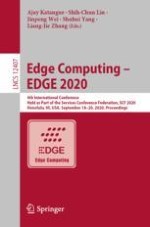2020 | Book
Edge Computing – EDGE 2020
4th International Conference, Held as Part of the Services Conference Federation, SCF 2020, Honolulu, HI, USA, September 18-20, 2020, Proceedings
Editors: Ajay Katangur, Shih-Chun Lin, Dr. Jinpeng Wei, Shuhui Yang, Liang-Jie Zhang
Publisher: Springer International Publishing
Book Series : Lecture Notes in Computer Science
